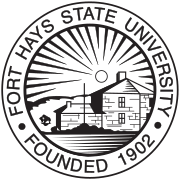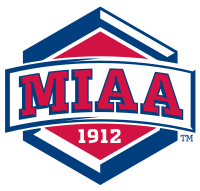Fort Hays State University
Fort Hays State University (FHSU) is a public university in Hays, Kansas, United States. It is the third-largest of the six state universities governed by the Kansas Board of Regents, with an enrollment of approximately 15,100 students (4,648 on campus, 6,882 online, 3,570 Chinese program).
 | |
| Motto | Forward thinking. World ready. |
|---|---|
| Type | Public, coeducational |
| Established | 1902 |
Parent institution | Kansas Board of Regents |
| Endowment | $91.44 million (2017)[1] |
| Budget | $155.5 million[2] |
| President | Tisa Mason |
| Provost | Jeff Briggs (interim) |
Academic staff | 851 |
| Students | 15,908 (Fall 2019)[3] |
| Location | , , U.S. 38°52′24″N 99°20′36″W |
| Campus | Rural 200 acres (0.81 km2) |
| Colors | Black and gold[4] |
| Nickname | Tigers |
Sporting affiliations | NCAA Division II – The MIAA |
| Mascot | Victor E. Tiger |
| Website | fhsu.edu |
 | |
History
FHSU was founded in 1902 as the Western Branch of Kansas State Normal School, which is now known as Emporia State University. The institution was originally located on the grounds of Fort Hays, a frontier military outpost that was closed in 1889. The university served the early settlers' needs for educational facilities in the new region. The first building closer to Hays was completed in 1904, at which time the university moved to its present location. The modern campus is still located on a portion of the former military reservation from the fort. FHSU was first to be founded as an agricultural based school but was then determined to be a normal school. The normal school was supposed to be supported in part by the agricultural experiment station. For years the University Dairy Unit supplied the school cafeteria with fresh milk.[5]
During the Great Flood of 1951 a tributary of the Kansas River flooded nearly all of campus forcing a midnight evacuation.[5]
Presidents
- William S. Picken (1902–1913)[6]
- William A. Lewis (1913–1933)
- Clarence E. Rarick (1933–1941)
- Lyman D. Wooster (1941–1949)
- Morton C. Cunningham (1949–1969)
- John W. Gustad (1969–1975)
- Gerald W. Tomanek (1975–1987)
- Dr. Edward H. Hammond (1987–2014)
- Dr. Mirta M. Martin (2014–2016)
- Mike Barnett (acting) (2016)
- Dr. Andy Tompkins (interim) (2016–2017)
- Dr. Tisa Mason (2017–present)
Possible merge with Dodge City Community College
In March 2014, it was announced that Dodge City Community College might become part of Fort Hays State University under a proposal that would create the first public four-year degree-granting college in southwest Kansas.[7] The college would then be known as Fort Hays State University at Dodge City if the plan is approved by the Kansas Board of Regents. Fort Hays faculty might teach other four-year programs in Dodge City, while courses typically taken by college freshmen and sophomores would remain the same. The proposal would also require $10 million to build a technical institute and $5 million per year in state funding.[8] If the Board of Regents approve it, then it must also be approved by the state Legislature and the governor.[9]
On November 11, 2014, the community college's Board of Trustees voted 3–3 on a proposal that recommended that Fort Hays become an upper division college and technical institute in Dodge City, with the Dodge City college remaining independent. With this vote, the merger has collapsed and will not happen.[10]
The campus
The main campus sits on 200 acres (0.81 km2) of the 4,160 acres (16.8 km2) owned by the state and deeded to the university. The campus property includes more than 40 limestone-faced buildings. Big Creek, a winding stream that traverses the campus, not only enhances the beauty of the campus, but also serves as a natural laboratory for students in the biological sciences. The campus is located just to the west of the Hays business district, two miles (3.2 km) south of Interstate 70. Several businesses in downtown Hays cater specifically to FHSU students.
Buildings
The buildings of Fort Hays State University are all dedicated to someone or are an important part of FHSU's history.[11]
| Building name | Function of building |
|---|---|
| Picken Hall | Admissions, Financial Aid, Graduate and personnel offices, the Docking Institute of Public Affairs |
| Martin Allen Hall | Psychology Department |
| Rarick Hall | Colleges of Education and Arts and Sciences, Moss-Thorns Gallery of Art |
| Sheridan Hall | Administrative offices, Beach/Schmidt Performing Arts Center |
| Custer Hall | Co-ed residence hall, University Police Department, KAMS hall |
| Memorial Union | Student Health Center, Bookstore, Center for Student Involvement, a food service area, conference and meeting rooms, and a ballroom |
| McCartney Hall | Robbins College of Business and Entrepreneurship, Management Development Center, Robbins Banking Institute |
| Albertson Hall | College of Health and Sciences, Depart. of Agriculture, Biological Sciences, and Communication Sciences and Disorders |
| Davis Hall | Technology Studies Department |
| Agnew Hall | Co-ed suite style residence hall |
| Victor E. Village | Co-ed residence hall |
| McMindes Hall | Co-ed residence hall |
| Tiger Village | Greek Housing, Sigma Phi Epsilon, Sigma Sigma Sigma, Delta Zeta |
| Malloy/Palmer Hall | Music and Communications Department, Choral rehearsal hall, and Felten-Start Theatre |
| Forsyth Library | Library |
| Cunningham Hall | Athletic Department, Gross Memorial Coliseum |
| Stroup Hall | Nursing |
| Heather Hall | Co-ed suite style residence hall |
| Tomanek Hall | Chemistry, Physics, and Geosciences Department |
| Hammond Hall | Informatics Department, KFHS Radio Station, Tiger Media Network, Virtual College offices, University Relations offices |
| Beach Hall | Sternberg Museum of Natural History |
Forsyth Library
In addition to supporting the general needs of faculty, staff and students, Forsyth Library has a large collection of fiction and nonfiction material about Kansas and the American West, supported in part by the Elmer and Eartha Pugh Trust Fund. Topics include railroads, the cattle industry, cowboys, Native Americans and frontier life.
The William D. Pashchal World War II History Collection, donated by retired dentist William Paschal, contains books, declassified government documents, maps, photographs, and other materials.
The library is also the repository for the books, papers and periodicals of the Fort Hays Genealogy Society.
Sternberg Museum of Natural History

The university's Sternberg Museum of Natural History features interactive natural science exhibitions, many traveling and temporary exhibitions, an acclaimed Discovery Room, and a Museum Store. The museum houses over 100,000 square feet (10,000 m2) of dinosaurs, fossils, prehistoric animals, giant sea-swimming lizards and fish that inhabited Kansas over 70–80 million years ago. The Sternberg Museum also includes more than 3.7 million specimens in collections of paleontology, geology, history, archaeology, ethnology, botany, entomology, ichthyology, herpetology, ornithology and mammalogy. One will find that all these major exhibits contain at least one creature/plant named after Sternberg.
The university's museum was renamed the Sternberg Memorial Museum after the death in 1969 of George F. Sternberg, who had developed it. The current museum was formed in 1991 when the university's museum was merged with the Museum of the High Plains.[12]
The museum is the home of the famous Cretaceous fossil Gillicus in Xiphactinus, better known as the "fish within a fish," which shows a small fossil fish inside the stomach of a larger fossil fish.
In 2010, researchers at the museum showed that plankton-eating fish flourished in the ocean at the same time as the dinosaurs, filling in a 106-million-year gap in the fossil record. One of the authors of the paper was Mike Everhart, a curator of paleontology at the museum.[13]
Academics
FHSU comprises five colleges (Arts, Humanities and Social Sciences; Business and Entrepreneurship; Education; Health and Behavioral Sciences; and Science, Technology and Mathematics) which together have 31 departments and offer more than 60 academic majors for undergraduates and 20 for graduate students.[14] Students at FHSU can obtain associate's degrees in office technology and radiologic technology; do their preprofessional study at FHSU then transfer to a medical or law school; obtain bachelor's and master's degrees; and in some areas of the curriculum, can earn specialist's degrees. FHSU also offers online degrees through its "Virtual College," a unit that evolved from the Department of Continuing Education and Learning Technology in 1999.
Docking Institute of Public Affairs
The Docking Institute is a public policy research institute whose mission is to enhance effective decision-making among governmental and non-profit leaders. The Institute has six focus areas:
- Survey research, program evaluation research, public policy research, and community and economic development research
- Strategic planning and consulting
- Grants facilitation
- Economic and community development consulting
- Public administration training programs
- Public affairs programming (conferences, speakers, forums, media events, scholarly publications, etc.)
In addition, the university hosts the Sebelius Lecture Series each year. The series is named for former United States Representative Keith Sebelius, who graduated from Fort Hays State University in 1941. Each semester, Fort Hays State University invites nationally recognized leaders to the campus to serve as keynote speakers.[15]
Athletics
Fort Hays State athletic teams participate in the NCAA Division II Mid-America Intercollegiate Athletics Association (MIAA). The Fort Hays State basketball programs hold four national basketball titles; the men's team claimed national championships in 1984 and 1985 (NAIA), back to back, and in 1996 (NCAA Division II) with a remarkable 34–0 record. The women's team also brought home the national title in 1991 (NAIA). The men's cross country program owns four national championships, all as a member of the NAIA, occurring in 1963, 1965, 1968, and 1969. The baseball program was NCAA Division II national runner-up in 2000. FHSU Shooting Team won 3rd place in 2009 in the American Trap event at the National ACUI competition.
Mascot
The Tiger has been the mascot of FHSU since 1914. Its origin is unclear, but it may have been the brainchild of W.A. Lewis, the president of the Western Branch Normal School (FHSU). Many tigers have represented FHSU over the years, but on April 3, 2000, the current mascot was unveiled. It is now the only accepted image of the FHSU Tiger. At the annual TailGreat on September 9, 2000, the mascot was officially named Victor E. Tiger. The costumed tiger character, Victor E. Tiger, appears at sporting and university events and is currently worn by Dawna Evers, a senior at the university.[16]
Oktoberfest and homecoming weekend
Each year, Fort Hays State holds a celebration called Oktoberfest. It is a celebration of the Volga German heritage of Ellis County. It is held at Frontier Park in downtown Hays on the Friday before FHSU's homecoming. For entertainment, there is polka music and various booths that serve a variety of German food and beer. The first keg is tapped around 11:00 a.m. which officially begins Oktoberfest. There is also a homecoming parade on Saturday morning where student organizations decorate floats or walk in the parade for FHSU spirit. The homecoming football game begins Saturday afternoon.
Student media
Student Media at Fort Hays is housed under the banner Tiger Media Network, which includes radio and TV, stemming from their website at tigermedianet.com.[17]
Notable alumni
- Vashone Adams, NFL player
- Greg Anderson, personal trainer linked to the BALCO steroids scandal
- Sheila Frahm, Former Lieutenant Governor of Kansas and Former United States Senator
- Kris Kuksi, visual artist
- M. T. Liggett, folk sculptor
- Kathryn McCarthy, U.S. Representative from Kansas
- Mike McCarthy, NFL Head Coach
- Tim McCarty, East Central University football coach
- Milton McGriggs, American football player
- Les Miller, NFL player
- Frankie Neal, NFL player
- Nola Ochs, world's oldest college graduate (95 in 2007)
- Pillar, band which formed at the university in 1998
- Jason Rees, professional baseball player
- Nathan Shepherd, NFL player
References
- As of June 30, 2017. "U.S. and Canadian Institutions Listed by Fiscal Year (FY) 2017 Endowment Market Value and Change in Endowment Market Value from FY2016 to FY2017" (PDF). Archived from the original (PDF) on March 6, 2018. Retrieved January 30, 2018.
- "Fort Hays State University QuickFacts - Fort Hays State University". Retrieved July 17, 2015.
- "BOARD OF REGENTS ANNOUNCES 2019 FALL SEMESTER ENROLLMENT" (PDF). October 2, 2019. Retrieved November 21, 2019.
- FHSU Identity Standards Manual (PDF). Retrieved November 27, 2017.
- "Fort Hays State University, Kansas - History and Information". Retrieved June 18, 2016.
- "Presidents - Fort Hays State University". fhsu.edu. Archived from the original on October 13, 2014. Retrieved November 8, 2013.
- "Fort Hays, Dodge Community College discuss merger". Retrieved June 18, 2016.
- FHSU might teach other 4-year programs
- maintained Salina Media Group. "Commissions Approve Proposed College Merger". ksal.com.
- Greg Palmer. "The Fort Hays State - Dodge City College Merger Is Off". wibw.com.
- "buildings - Fort Hays State University". fhsu.edu.
- "Fort Hays Sternberg Museum of Natural History: History". Fort Hays State University. 2002–2013. Retrieved March 29, 2013.
- Kellerman, Mark (2010). "Sternberg Museum Helps with a Top Science Story". Fort Hays State University. Retrieved March 29, 2013.
- "Academic Departments & Colleges - Fort Hays State University". www.fhsu.edu. Retrieved July 2, 2019.
- "FHSU Docking Institute - About - Fort Hays State University". Fhsu.edu. Retrieved July 17, 2015.
- "university mascot mark. - Fort Hays State University". Fhsu.edu. Archived from the original on July 21, 2015. Retrieved July 17, 2015.
- "Tiger Media Network". fhsu.edu.
